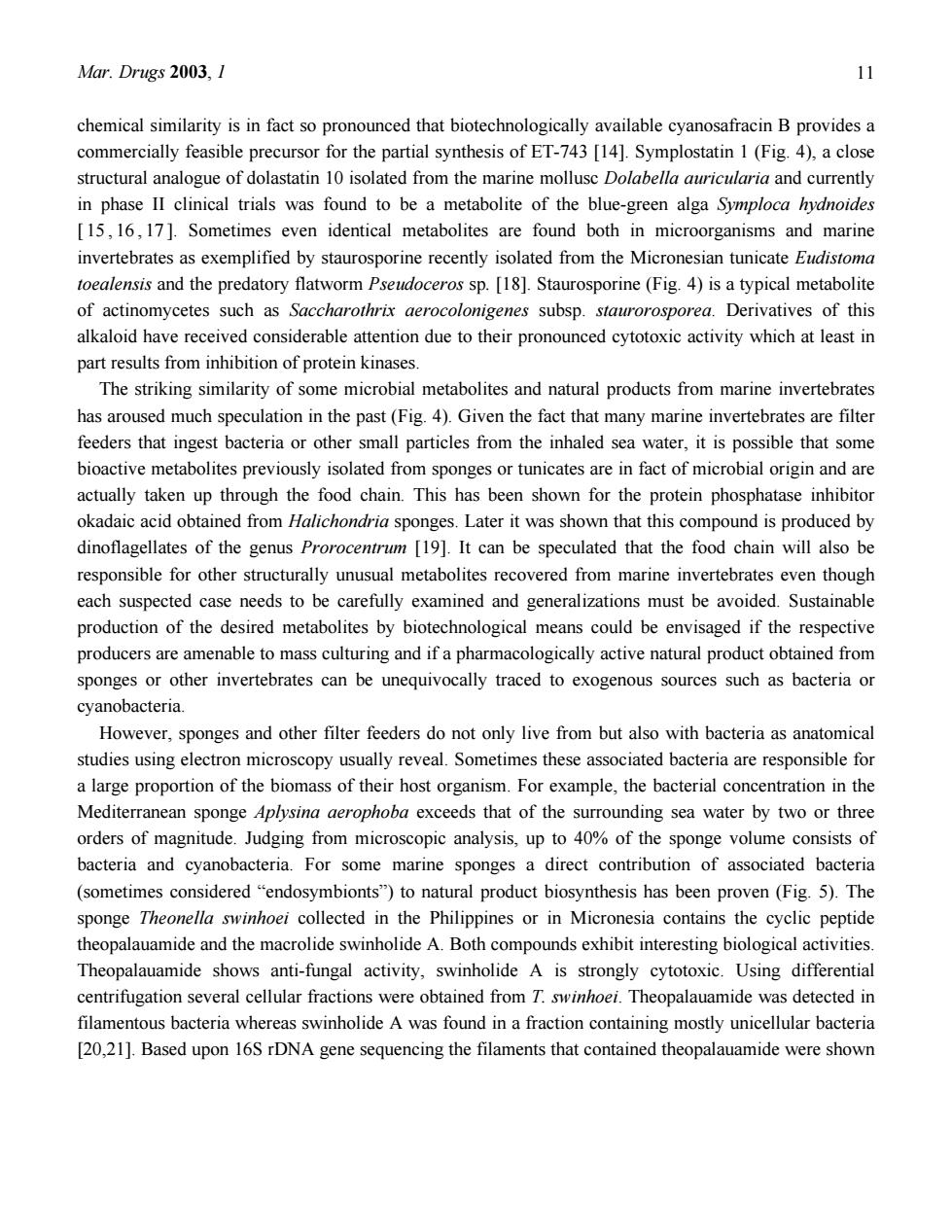正在加载图片...

Mar.Drugs 2003,1 chemical similarity is in fact so pronounced that biotechnologically available cyanosafracin B provides a commercially feasible precursor for the partial synthesis of ET-743 [14].Symplostatin 1 (Fig.4).a close structural analogue of dolastatin 10 isolated from the marine mollusc Dolabella auricularia and currently in phase II clinical trials was found to be a metabolite of the blue-green alga Symploca hydnoides [15,16,17].Sometimes even identical metabolites are found both in microorganisms and marine invertebrates as exemplified by staurosporine recently isolated from the Micronesian tunicate Eudistom toealensis and the predatory flatworm Pseudoceros sp.[18].Staurosporine (Fig.4)is a typical metabolite of actinomycetes such as Saccharothrix aerocolonigenes subsp.staurorosporea.Derivatives of this alkaloid have received considerable attention due to their pronounced cytotoxic activity which at least in part results from inhibition of protein kinases The striking similarity of some microbial metabolites and natural products from marine invertebrates has aroused much speculation in the past(Fig.4).Given the fact that many marine invertebrates are filter feeders that ingest bacteria or other small particles from the inhaled sea water,it is possible that some bioactive metabolites previously isolated from sponges or tunicates are in fact of microbial origin and are actually taken up through the food chain.This has been shown for the protein phosphatase inhibitor okadaic acid obtained from Halichondria sponges.Later it was shown that this compound is produced by dinoflagellates of the genus Prorocentrum[19].It can be speculated that the food chain will also be responsible for other structurally unusual metabolites recovered from marine invertebrates even though each suspected case needs to be carefully examined and generalizations must be avoided.Sustainable production of the desired metabolites by biotechnological means could be envisaged if the respective producers are amenable to mass culturing and if a pharmacologically active natural product obtained from sponges or other invertebrates can be unequivocally traced to exogenous sources such as bacteria or cyanobacteria. However,sponges and other filter feeders do not only live from but also with bacteria as anatomical studies using electron microscopy usually reveal.Sometimes these associated bacteria are responsible fo a large proportion of the biomass of their host organism.For example,the bacterial concentration in the Mediterranean sponge Aplysina aerophoba exceeds that of the surrounding sea water by two or three orders of magnitude.Judging from microscopic analysis,up to 40%of the sponge volume consists of bacteria and cyanobacteria.For some marine sponges a direct contribution of associated bacteria (sometimes considered"endosymbionts")to natural product biosynthesis has been proven(Fig.5).The sponge Theonella swinhoei collected in the Philippines or in Micronesia contains the cyclic peptide theopalauamide and the macrolide swinholide A.Both compounds exhibit interesting biological activities Theopalauamide shows anti-fungal activity,swinholide A is strongly cytotoxic.Using differential centrifugation several cellular fractions were obtained from T.swinhoei.Theopalauamide was detected in filamentous bacteria whereas swinholide A was found in a fraction containing mostly unicellular bacteria [20.21].Based upon 16S rDNA gene sequencing the filaments that contained theopalauamide were shown Mar. Drugs 2003, 1 11 chemical similarity is in fact so pronounced that biotechnologically available cyanosafracin B provides a commercially feasible precursor for the partial synthesis of ET-743 [14]. Symplostatin 1 (Fig. 4), a close structural analogue of dolastatin 10 isolated from the marine mollusc Dolabella auricularia and currently in phase II clinical trials was found to be a metabolite of the blue-green alga Symploca hydnoides [ 15 , 16 , 17 ]. Sometimes even identical metabolites are found both in microorganisms and marine invertebrates as exemplified by staurosporine recently isolated from the Micronesian tunicate Eudistoma toealensis and the predatory flatworm Pseudoceros sp. [18]. Staurosporine (Fig. 4) is a typical metabolite of actinomycetes such as Saccharothrix aerocolonigenes subsp. staurorosporea. Derivatives of this alkaloid have received considerable attention due to their pronounced cytotoxic activity which at least in part results from inhibition of protein kinases. The striking similarity of some microbial metabolites and natural products from marine invertebrates has aroused much speculation in the past (Fig. 4). Given the fact that many marine invertebrates are filter feeders that ingest bacteria or other small particles from the inhaled sea water, it is possible that some bioactive metabolites previously isolated from sponges or tunicates are in fact of microbial origin and are actually taken up through the food chain. This has been shown for the protein phosphatase inhibitor okadaic acid obtained from Halichondria sponges. Later it was shown that this compound is produced by dinoflagellates of the genus Prorocentrum [19]. It can be speculated that the food chain will also be responsible for other structurally unusual metabolites recovered from marine invertebrates even though each suspected case needs to be carefully examined and generalizations must be avoided. Sustainable production of the desired metabolites by biotechnological means could be envisaged if the respective producers are amenable to mass culturing and if a pharmacologically active natural product obtained from sponges or other invertebrates can be unequivocally traced to exogenous sources such as bacteria or cyanobacteria. However, sponges and other filter feeders do not only live from but also with bacteria as anatomical studies using electron microscopy usually reveal. Sometimes these associated bacteria are responsible for a large proportion of the biomass of their host organism. For example, the bacterial concentration in the Mediterranean sponge Aplysina aerophoba exceeds that of the surrounding sea water by two or three orders of magnitude. Judging from microscopic analysis, up to 40% of the sponge volume consists of bacteria and cyanobacteria. For some marine sponges a direct contribution of associated bacteria (sometimes considered “endosymbionts”) to natural product biosynthesis has been proven (Fig. 5). The sponge Theonella swinhoei collected in the Philippines or in Micronesia contains the cyclic peptide theopalauamide and the macrolide swinholide A. Both compounds exhibit interesting biological activities. Theopalauamide shows anti-fungal activity, swinholide A is strongly cytotoxic. Using differential centrifugation several cellular fractions were obtained from T. swinhoei. Theopalauamide was detected in filamentous bacteria whereas swinholide A was found in a fraction containing mostly unicellular bacteria [20,21]. Based upon 16S rDNA gene sequencing the filaments that contained theopalauamide were shown